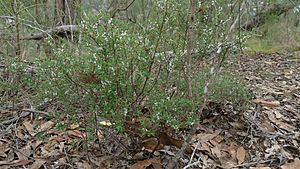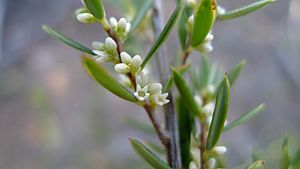Prickly broom heath facts for kids
Quick facts for kids Prickly broom heath |
|
|---|---|
 |
|
 |
|
| Scientific classification | |
| Genus: |
Monotoca
|
| Species: |
scoparia
|
| Synonyms | |
|
|
Monotoca scoparia, also known as prickly broom heath, is a common plant found all over south-eastern Australia. This plant used to be in the Epacridaceae family. Now, it's part of the Ericaceae family, which includes plants like blueberries and rhododendrons. The Monotoca group has 17 different species, and they all grow only in Australia.
Contents
What Does Prickly Broom Heath Look Like?
Monotoca scoparia is a type of shrub that can grow from about 30 to 120 centimeters tall. It has a special woody swelling at its base called a lignotuber. This helps the plant regrow after fires.
Leaves and Branches
The leaves grow in an alternating pattern along the stem. They are upright and feel prickly. Their shape is narrow and oblong, or sometimes elliptic. Each leaf is about 0.6 to 2.2 centimeters long and 1 to 4 millimeters wide. The top side of the leaf is dark green. The bottom side is a pale green or whitish color. You can see 3 to 5 clear veins on the underside. The tips of the leaves are sharp. The small branches can feel rough or be smooth.
Flowers and Fruit
This plant has male and female flowers on different plants. The flowers are shaped like tubes and are white to cream in color. They grow in clusters of 2 to 9 flowers. These clusters appear where the leaves meet the stem. Sometimes, a single flower grows at the very bottom.
The female flowers have a tube-shaped part called a corolla that is 1.3 to 2.8 millimeters long. The male corolla is a bit longer, from 2 to 4 millimeters. Monotoca scoparia flowers for most of the year, usually from December to August. The fruit is fleshy and oblong, turning yellow to orange when ripe. A key feature of this plant's flower is that its corolla tube is longer than the sepals (the small leaf-like parts at the base of the flower).
Where Does Prickly Broom Heath Grow?
Monotoca scoparia is found across many parts of Australia. It has been seen in Tasmania, Victoria, New South Wales, and Queensland. There are also a few sightings in the Northern Territory and South Australia.
This plant often grows as a common shrub under taller trees. You can find it in dry sclerophyll forests, woodlands, and heathlands. It prefers sandy and rocky soils that drain water well. It can grow from sea-level all the way up to mountain areas. It likes full sun but can also grow in partial shade.
Similar Species in Tasmania
Tasmania has six native species of Monotoca. These species can be quite similar and hard to tell apart. One very similar plant is Monotoca submutica, which only grows in Tasmania. Some people think of it as a variety of Monotoca scoparia.
Monotoca scoparia and Monotoca submutica look very much alike. However, the flowers of Monotoca scoparia are longer. Also, they bloom at different times of the year. These two plants also prefer different habitats. Monotoca submutica grows in subalpine forests and wet sclerophyll rainforests across southern and western Tasmania.
Why Is Prickly Broom Heath Important?
Monotoca scoparia and other heath plants are a vital food source for some animals. For example, the Smoky mouse (Pseudomys fumeus) in New South Wales eats this plant. The Smoky mouse is an endangered rodent, meaning it's at risk of disappearing forever.
Studies have shown that Monotoca scoparia is a major part of the Smoky mouse's diet. This means that the presence of Monotoca scoparia is very important for the survival of this endangered species. It also helps other animals that rely on it for food.
Growing It in Your Garden
Monotoca scoparia is often used in gardens. For the best results, plant this prickly shrub in a spot that gets good drainage. It should also get full sun or partial shade. It can even grow well under existing trees. Gardeners often use Monotoca scoparia for hedges or to help guide people's paths.

